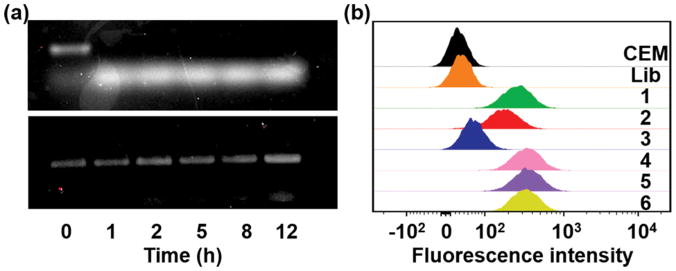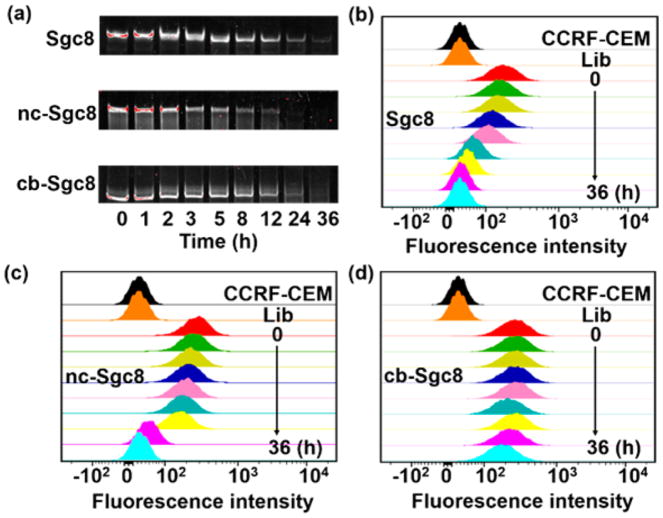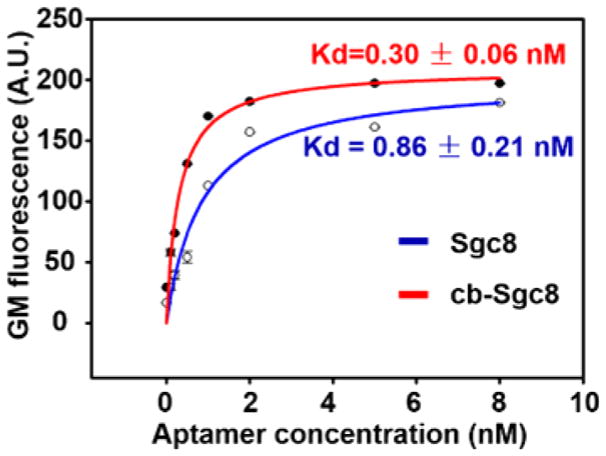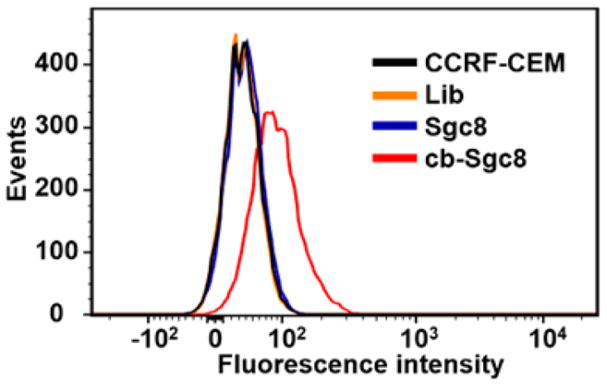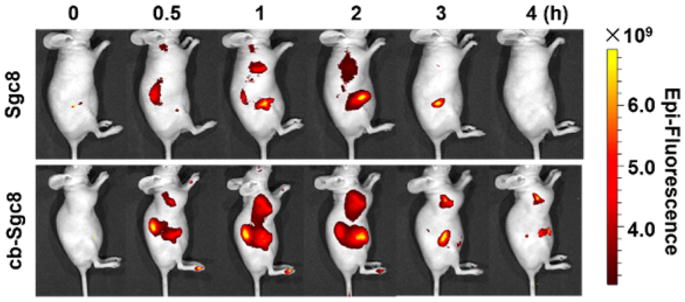Abstract
Aptamers are powerful candidates for molecular imaging and targeted therapy of cancer based on such appealing features as high binding affinity, high specificity, site-specific modification and rapid tumor penetration. However, aptamers are susceptible to plasma exonucleases in vivo. This seriously affects their in vivo applications. To overcome this key limitation, we herein report the design and development of circular bivalent aptamers. Systematic studies reveal that cyclization of aptamers can improve thermal stability, nuclease resistance and binding affinity. In vivo fluorescence imaging further validates the efficient accumulation and retention of circular bivalent aptamers in tumors compared to “mono-aptamers”. Therefore, this study provides a simple and efficient strategy to boost in vivo aptamer applications in cancer diagnosis and therapy.
Aptamers are nucleic acid (NA) probes generated from an in vitro process known as SELEX (systematic evolution of ligands by exponential enrichment).1,2 By folding into distinct tertiary structures, aptamers can specifically recognize a panel of targets, such as metal ions, organic molecules and proteins, with dissociation constants down to picomolar values.3,4 Based on low molecular weight, aptamers have rapid tissue and tumor penetration, as well as rapid blood clearance.5,6 Because they consist of nucleotides, aptamers are nonimmunogenic and, as such, they can be easily synthesized and modified, allowing site-specific modification for conjugation of fluorescent dyes, radionuclides, drugs and pharmacokinetic modifying agents.6–8 Importantly, it has been revealed that aptamers generated from SELEX can discriminate between the molecular signatures of normal and cancer cells.9,10 Therefore, aptamers have attracted extensive attention as molecular probes in cancer diagnosis and therapy.6,11,12
A prerequisite for successful in vivo application of aptamers, as molecular probes and targeted drugs, is stability against in vivo degradation. Natural NAs are susceptible to biological media, especially serum, which seriously hampers the practical applications of aptamers.13 To improve the stability of aptamers in biological fluids, many elegant strategies have been developed. Chemical modifications, including postselection modification and SELEX with modified oligonucleotide libraries (modified SELEX), are the conventional methods used to generate nuclease-resistant aptamers.14–18 Macugen, an approved aptamer drug, is a vivid example of nuclease-resistant aptamers generated with modified SELEX.19 However, modified nucleotides must be compatible with polymerases in SELEX, and such postselection modifications can affect aptamer specificity and affinity.20,21 In addition, strategies to protect aptamers from degradation based on steric hindrance existing at the nanoparticle-aptamer interface have also been developed.22–24 However, this method can be faulted for its complicated preparation and side effects associated with nanomaterials. Therefore, virtually none of these strategies fully meets acceptable standards for clinical use, including those related to thermal stability, nuclease resistance, and binding affinity.
In particular, the successful use of aptamers in vivo depends on conformational stability in a complex matrix, but we need to make a distinction. Although conformational flexibility is a hallmark of aptamers in the context of target recognition, it is still a key factor limiting the affinity and specificity of interactions arising from the conformational energy penalty.25 In other words, the flexible conformation of aptamers can adversely affect their binding ability and specificity. Furthermore, this conformational flexibility allows easy exposure of the aptamer’s single-stranded regions, rendering them susceptible to nuclease attack.26 It is well-known that bivalent cationic ions, for example Mg2+, play an essential role in maintaining the tertiary structure and binding ability of aptamers. However, the concentrations of Ca2+ and Mg2+ in human serum are usually low,27 thus contributing to increased instability by encroachment of nucleases. Accordingly, practical clinical use calls for the improvement of thermal stability to facilitate both in vivo stability and binding affinity of aptamers.
Easily degradable NAs present a problem that predominantly arises from the exonuclease activity of blood products.26,28 Recently, studies on circular RNA, which arise from direct back-splicing events that covalently link the 3′-terminus of an exon with the 5′-terminus of either the same exon or a further upstream exon, reveal that circular RNAs have enhanced stability compared to linear RNAs due to lack of free ends.29–31 Therefore, cyclization of NAs by ligation of 5′-terminus and 3′-terminus using chemical methods or ligase can entirely eliminate the primary source of degradation, providing a simple and efficient strategy to improve the stability of aptamers in serum. For example, King et al. developed circular multivalent aptamers as an efficient anticoagulant.32 Cyclization of NAs can also ensure the conformational integrity of NAs by increasing their thermal stability.33 Enlighted by circular structure in these cases, and with the purpose of improving in vivo performance of aptamers, three aptamers (Sgc8,9 TD0534 and XQ-2d21) selected against live cancer cells were chosen to construct circular bivalent aptamers (cb-aptamers). Thermal stability, nuclease resistance, binding affinity and in vivo performance of cb-aptamers were systematically explored and compared with their precursors.
To construct a cb-aptamer, their two components with 5′-phosphate group and 3′-OH group were designed with additional flanking complementary sequences (Table S1). The additional complementary sequences could hybridize, allowing the formation of a hybrid bivalent aptamer with two nicks (nc-aptamer). Cb-aptamers could then be prepared by sealing the two nicks in the nc-aptamer with T4 DNA ligase (Figure 1). To improve the efficiency of cb-aptamer preparation, annealing conditions and the lengths of complementary sequences were investigated by agarose electrophoresis. As shown in Figure S1, quick chilling of the denatured Sgc8 with 9-base, 13-base or 17-base complementary sequences could more efficiently facilitate the formation of cb-aptamer compared to slow chilling. Compared with annealing conditions, the lengths of additional complementary sequences had little effect on the formation of cb-Sgc8. However, cb-Sgc8 containing additional 13-base complementary sequences had better binding ability than cb-Sgc8 containing additional 9-base or 17-base complementary sequences at the same concentration (Figure S2). Therefore, we chose quick chilling of the denatured aptamers with additional 13-base complementary sequences at the 5′-terminus to prepare cb-Sgc8 (Figure 1) and other cb-aptamers.
Figure 1.
Formation of cb-Sgc8, as determined by agarose gel electrophoresis. The cb-Sgc8 (lane 3) was prepared with FAM-labeled Sgc8 with complementary sequences (lane 1 and 2).
Thermal melting analysis of cb-Sgc8 was carried out and compared to that of monovalent Sgc8, nc-Sgc8 and the double stranded duplex fragment of cb-Sgc8 (Table S3). Their melting temperatures (Tm) in different buffers are summarized in Table S4. Results showed that cb-Sgc8 had higher Tm values in all three buffers than Sgc8 and nc-Sgc8 with differences of more than 30 °C, and duplex fragment of cb-Sgc8 with differences of more than 10 °C. Results also showed that the concentrations Na+ or Mg2+ had little effect on the Tm value of cb-Sgc8. This means that cyclization could result in the increase of the thermal stability of aptamer, which is expected to provide more stable overall structure for target binding due to its lower entropic penalty.25,26
The effect of cyclization on the physical stability of sgc8 in biological media was also investigated. Figure 2a shows that Sgc8 could be easily degraded after incubation with 0.25 U/μL Exo I for 1 h. However, cb-Sgc8 could sustain harsh conditions and retain sequence integrity, even after incubation with 0.25 U/μL for 12 h. The stability of aptamers treated with Exo I were also studied by flow cytometry. As shown in Figure 2b, cb-Sgc8 retained its binding ability after incubation with 0.5 U/μL Exo I for 1 h. However, Sgc8 significantly lost its binding ability after incubation with 0.25 U/μL Exo I for 1 h. The stability of monovalent aptamer, nc-aptamer and cb-aptamer in 10% FBS was also tested. As shown in Figure 3a, Sgc8 and nc-Sgc8 were unstable in 10% FBS, and Sgc8 and nc-Sgc8 bands disappeared after incubation in 10% FBS for 8 h and for 24 h, respectively. However, when cb-Sgc8 was incubated with 10% FBS for 36 h, the integrity of the cb-Sgc8 band was still evident. The results from flow cytometry were highly consistent with those of PAGE. As shown in Figure 3, Sgc8 and nc-Sgc8 significantly lost their binding ability after 8 or 24 h of incubation, respectively. However, cb-Sgc8 could bind to target cells after 36 h of incubation in 10% FBS. Therefore, on the basis of the stability analyses of aptamers treated with Exo I and 10% FBS, it can be concluded that aptamer cyclization increases stability in biological media when compared to precursor.
Figure 2.
Stability analysis of cb-Sgc8 and Sgc8 after treatment with Exo I. (a) Stability analysis of Sgc8 (upper) and cb-Sgc8 (lower) after incubation in 0.25 U/μL Exo I for different times, as determined by agarose electrophoresis. (b) Binding ability analysis of Sgc8 and cb-Sgc8 after treatment with Exo I, as determined by flow cytometry. The peak represents the fluorescence intensity of CCRF-CEM cells treated with library, Sgc8 (1), Sgc8 incubated in 0.25 U/μL Exo I for 1 h (2), Sgc8 incubated in 0.5 U/μL Exo I for 1 h (3), cb-Sgc8 (4), cb-Sgc8 incubated in 0.25 U/μL Exo I for 1 h (5), and cb-Sgc8 incubated in 0.5 U/μL Exo I for 1 h (6). The concentrations of Lib, Sgc8 and cb-Sgc8 in the flow cytometric assay were 10, 10 and 5 nM, respectively.
Figure 3.
Stability analysis of aptamers after treatment with 10% FBS. (a) Stability analysis of cb-Sgc8, nc-Sgc8 and Sgc8 after incubation with 10% FBS for different times, as determined by PAGE. (b) Flow cytometry assay of CCRF-CEM cells treated with Sgc8 from panel a. (c) Flow cytometry assay of CCRF-CEM cells treated with nc-Sgc8 from panel a. (d) Flow cytometry assay of CCRF-CEM cells treated with cb-Sgc8 from panel a. The concentrations of Lib, Sgc8, nc-Sgc8 and cb-Sgc8 in flow cytometric assay were 10, 10, 5 and 5 nM, respectively. The incubation temperature was 4 °C.
The stability of cb-Sgc8 in 0.5 U/μL Exo I and 10% FBS were further compared to monovalent Sgc8 containing an inverted dT at 3′-terminus, 10 phosphorothioate oligonucleotides or 6 2′-O-methyl oligoribonucleotides (Table S5). As shown in Figure S3, cb-Sgc8 has better stability than monovalent aptamer with inverted dT at 3′-terminus, but has similar stability compared with aptamers modified with phosphorothioate oligonucleotides and 2′-O-methyl oligoribonucleotides.
Compared with monovalent aptamer, cb-aptamer has two recognition motifs. Thus, cb-aptamer would be expected to have better binding ability to cancer cells than monovalent aptamer. As shown in Figure 4, cb-Sgc8 could bind to CCRF-CEM cells with an equilibrium dissociation constant (Kd of 0.30 ± 0.06 nM), which was 2-fold lower than that of Sgc8 (Kd of 0.86 ± 0.21 nM). Flow cytometry and confocal microscopy also revealed that cb-Sgc8 retained high specificity without binding Ramos cells, even at high concentration of 150 nM (Figure S4). Cb-Sgc8 enhanced both binding affinity and internalization of Sgc8. In addition, cb-Sgc8 also produced more intracellular fluorescence signals in CCRF-CEM cells than Sgc8 after 4 h of incubation at 37 °C (Figure S5). This result suggests that cb-Sgc8 can more efficiently enter cells compared to Sgc8 and that it is more efficient in drug delivery. The binding ability of circular trivalent Sgc8 (ct-Sgc8) was also tested and compared with that of cb-Sgc8 and Sgc8. As expected, CCRF-CEM cells presented still higher fluorescence signal than cells treated with cb-Sgc8 or Sgc8 (Figure S6). However, in this study, only cb-aptamer was further characterized and investigated.
Figure 4.
Binding affinity analysis of cb-Sgc8 and Sgc8 at 4 °C.
It is well-known that divalent cations, for example Mg2+, play an essential role in forming tertiary structure, which, correspondingly, affects the binding ability of aptamers. Thus, the binding ability of cb-Sgc8 and Sgc8 in binding buffer with low Mg2+ concentration (0.66 mM) was studied by flow cytometry. As shown in Figure 5, cb-Sgc8, not Sgc8, could bind to CCRF-CEM cells at 4 °C. This result suggests that cb-aptamers can expand applications in conditions different from those imposed during selection.
Figure 5.
Flow cytometric assay of binding ability of cb-Sgc8 and Sgc8 to CCRF-CEM cells at 4 °C in binding buffer containing 0.66 mM Mg2+. The concentrations of Lib, Sgc8 and cb-Sgc8 were 5, 5 and 2.5 nM, respectively.
To determine whether cb-aptamers could be used as a general strategy to enhance aptamer stability and binding ability, TD05 aptamer selected against Burkitt’s lymphoma Ramos cells and XQ-2d aptamer selected against pancreatic duct adenocarcinoma PL45 cells were also chosen to construct cb-aptamers. The stability analysis of cb-TD05 and cb-XQ-2d showed that cyclization of aptamer clearly improved their stability in Exo I and 10% FBS, which are coincident with results of stability analysis of cb-Sgc8 (Figure S7 and Figure S8). The binding ability of cb-aptamers and their precursors was analyzed by flow cytometry and confocal microscopy. Both cb-TD05 and cb-XQ-2d showed better binding ability than their respective precursors (Figure S9 and Figure S10). Furthermore, compared to monoaptamer TD05, cb-TD05 could even bind to Ramos cells at 37 °C (Figure S9 and Figure S11). These data suggest that cb-aptamers provide a simple method to improve the binding ability of a monovalent aptamer.
To test whether cb-aptamers would improve the performance of aptamers for in vivo applications, we systematically compared the performance of Cy5-labeled cb-Sgc8 against that of Cy5-labeled Sgc8 and Cy5-labeled library control in illuminating CCRF-CEM tumors in vivo. After injection of Cy5-labeled library into CCRF-CEM tumor-bearing BALB/c-nude mice through tail vein, no fluorescence signal was observed at the tumor site during the entire procedure (Figure S12). When Cy5-labeled Sgc8 was injected into mice bearing CCRF-CEM tumor through tail vein, an obvious fluorescence signal could be seen at the tumor site about 1 h postinjection (Figure 6). However, the fluorescence signal significantly decreased at 2 h and almost completely disappeared at 3 h postinjection. When Cy5-labeled cb-Sgc8 was injected into CCRF-CEM tumor-bearing mice through tail vein, an obvious fluorescence signal could be seen in the tumor site 30 min postinjection, followed by an increase of fluorescence signal at the tumor site at 1 h postinjection. At 2 h postinjection of cb-Sgc8, the fluorescence signal at the tumor site showed little decrease. It was surprising that an obvious fluorescence signal of Cy-5-labeled cb-Sgc8 remained at 4 h postinjection. On the basis of these data, it is clear that cb-Sgc8 can more efficiently recognize, accumulate and remain in tumors compared to Sgc8. The increased performance of cb-Sgc8 is due to the improved stability of cb-aptamer in serum and better binding affinity to target cells. Therefore, our study suggests that cb-aptamers positively affect performance, making these bivalent aptamers much more suitable as candidates for practical clinical applications.
Figure 6.
In vivo fluorescence imaging of CCRF-CEM tumor-bearing mice after Cy5-labeled Sgc8 or cb-Sgc8 was injected through tail vein.
In summary, we reported the design and construction of nuclease-resistant circular bivalent aptamers for cancer cell recognition and tumor imaging. Compared with the precursor aptamer, cb-aptamers have improved thermal and physical stability in biological media, and, hence, better binding affinity, recognition, accumulation and retention in in vivo tumors. Aptamers selected via SELEX are known to recognize different cancer cell types and subtypes. Such aptamers allow site-specific modifications for conjugation of imaging agents and drugs. Therefore, by extending the features provided by cyclization of aptamers, we have suggested a simple and efficient strategy for the development of molecular probes suitable for clinical applications in cancer diagnosis and therapy.
Supplementary Material
Acknowledgments
This work is supported by the NSFC grants (NSFC 21221003 and NSFC 21327009) and by the National Institutes of Health (GM079359).
Footnotes
Notes
The authors declare no competing financial interest.
The Supporting Information is available free of charge on the ACS Publications website at DOI: 10.1021/jacs.7b04547.
Reagents and materials, the preparation of circular trivalent Sgc8, and additional characterization data (PDF)
References
- 1.Ellington AD, Szostak JW. Nature. 1990;346:818. doi: 10.1038/346818a0. [DOI] [PubMed] [Google Scholar]
- 2.Tuerk C, Gold L. Science. 1990;249:505. doi: 10.1126/science.2200121. [DOI] [PubMed] [Google Scholar]
- 3.Stoltenburg R, Reinemann C, Strehlitz B. Biomol Eng. 2007;24:381. doi: 10.1016/j.bioeng.2007.06.001. [DOI] [PubMed] [Google Scholar]
- 4.Fang X, Tan WH. Acc Chem Res. 2010;43:48. doi: 10.1021/ar900101s. [DOI] [PMC free article] [PubMed] [Google Scholar]
- 5.Jayasena SD. Clin Chem. 1999;45:1628. [PubMed] [Google Scholar]
- 6.Keefe AD, Pai S, Ellington AD. Nat Rev Drug Discovery. doi: 10.1038/nrd3141. [DOI] [PMC free article] [PubMed] [Google Scholar]
- 7.Wang R, Zhu G, Mei L, Xie Y, Ma H, Ye M, Qing FL, Tan WH. J Am Chem Soc. 2014;136:2731. doi: 10.1021/ja4117395. [DOI] [PMC free article] [PubMed] [Google Scholar]
- 8.Hicke BJ, Stephens AW, Gould T, Chang YF, Lynott CK, Heil J, Borkowski S, Hilger CS, Cook G, Warren S, Schmidt PG. J Nucl Med. 2006;47:668. [PubMed] [Google Scholar]
- 9.Shangguan D, Li Y, Tang Z, Cao ZC, Chen HW, Mallikaratchy P, Sefah K, Yang CJ, Tan WH. Proc Natl Acad Sci U S A. 2006;103:11838. doi: 10.1073/pnas.0602615103. [DOI] [PMC free article] [PubMed] [Google Scholar]
- 10.Tan WH, Donovan MJ, Jiang J. Chem Rev. 2013;113:2842. doi: 10.1021/cr300468w. [DOI] [PMC free article] [PubMed] [Google Scholar]
- 11.Zhou J, Rossi J. Nat Rev Drug Discovery. 2017;16:181. doi: 10.1038/nrd.2016.199. [DOI] [PMC free article] [PubMed] [Google Scholar]
- 12.Zhao L, Tang C, Xu L, Zhang Z, Li X, Hu H, Cheng S, Zhou W, Huang M, Fong A, Liu B, Tseng HR, Gao H, Liu Y, Fang X. Small. 2016;12:1072. doi: 10.1002/smll.201503188. [DOI] [PMC free article] [PubMed] [Google Scholar]
- 13.Osborne SE, Ellington AD. Chem Rev. 1997;97:349. doi: 10.1021/cr960009c. [DOI] [PubMed] [Google Scholar]
- 14.Dellafiore MA, Montserrat JM, Iribarren AM. Front Chem. 2016;4:18. doi: 10.3389/fchem.2016.00018. [DOI] [PMC free article] [PubMed] [Google Scholar]
- 15.Hicke BJ, Marion C, Chang YF, Gould T, Lynott CK, Parma D, Schmidt PG, Warren S. J Biol Chem. 2001;276:48644. doi: 10.1074/jbc.M104651200. [DOI] [PubMed] [Google Scholar]
- 16.Lee JH, Canny MD, De Erkenez A, Krilleke D, Ng YS, Shima DT, Pardi A, Jucker F. Proc Natl Acad Sci U S A. 2005;102:18902. doi: 10.1073/pnas.0509069102. [DOI] [PMC free article] [PubMed] [Google Scholar]
- 17.Kusser W. Rev Mol Biotechnol. 2000;74:27. doi: 10.1016/s1389-0352(99)00002-1. [DOI] [PubMed] [Google Scholar]
- 18.Lipi F, Chen S, Chakravarthy M, Rakesh S, Veedu RN. RNA Biol. 2016;13:1232. doi: 10.1080/15476286.2016.1236173. [DOI] [PMC free article] [PubMed] [Google Scholar]
- 19.Bunka DHJ, Stockley PG. Nat Rev Microbiol. 2006;4:588. doi: 10.1038/nrmicro1458. [DOI] [PubMed] [Google Scholar]
- 20.Shangguan D, Tang Z, Mallikaratchy P, Xiao Z, Tan WH. Chem Bio Chem. 2007;8:603. doi: 10.1002/cbic.200600532. [DOI] [PubMed] [Google Scholar]
- 21.Wu X, Zhao Z, Bai H, Fu T, Yang C, Hu X, Liu Q, Champanhac C, Teng IT, Ye M, Tan WH. Theranostics. 2015;5:985. doi: 10.7150/thno.11938. [DOI] [PMC free article] [PubMed] [Google Scholar]
- 22.Meng HM, Zhang X, Lv Y, Zhao Z, Wang NN, Fu T, Fan H, Liang H, Qiu L, Zhu G, Tan WH. ACS Nano. 2014;8:6171. doi: 10.1021/nn5015962. [DOI] [PMC free article] [PubMed] [Google Scholar]
- 23.Li J, Zheng C, Cansiz S, Wu C, Xu J, Cui C, Liu Y, Hou W, Wang Y, Zhang L, Teng IT, Yang HH, Tan WH. J Am Chem Soc. 2015;137:1412. doi: 10.1021/ja512293f. [DOI] [PMC free article] [PubMed] [Google Scholar]
- 24.Zhao Z, Fan H, Zhou G, Bai H, Liang H, Wang R, Zhang X, Tan WH. J Am Chem Soc. 2014;136:11220. doi: 10.1021/ja5029364. [DOI] [PubMed] [Google Scholar]
- 25.Eaton BE, Gold L, Zichi DA. Chem Biol. 1995;2:633. doi: 10.1016/1074-5521(95)90023-3. [DOI] [PubMed] [Google Scholar]
- 26.Schmidt KS, Borkowski S, Kurreck J, Stephens AW, Bald R, Hecht M, Friebe M, Dinkelborg L, Erdmann VA. Nucleic Acids Res. 2004;32:5757. doi: 10.1093/nar/gkh862. [DOI] [PMC free article] [PubMed] [Google Scholar]
- 27.Andrusishina IN. J Elem. 2010;15:425. [Google Scholar]
- 28.Shaw JP, Kent K, Bird J, Fishback J, Froehler B. Nucleic Acids Res. 1991;19:747. doi: 10.1093/nar/19.4.747. [DOI] [PMC free article] [PubMed] [Google Scholar]
- 29.Hansen TB, Jensen TI, Clausen BH, Bramsen JB, Finsen B, Damgaard CK, Kjems J. Nature. 2013;495:384. doi: 10.1038/nature11993. [DOI] [PubMed] [Google Scholar]
- 30.Cortés-López M, Miura P. Yale J Biol Med. 2016;89:527. [PMC free article] [PubMed] [Google Scholar]
- 31.Memczak S, Jens M, Elefsinioti A, Torti F, Krueger J, Rybak A, Maier L, Mackowiak SD, Gregersen LH, Munschauer M, Loewer A, Ziebold U, Landthaler M, Kocks C, le Noble F, Rajewsky N. Nature. 2013;495:333. doi: 10.1038/nature11928. [DOI] [PubMed] [Google Scholar]
- 32.Di Giusto DA, King GC. J Biol Chem. 2004;279:46483. doi: 10.1074/jbc.M408037200. [DOI] [PubMed] [Google Scholar]
- 33.Tang X, Su M, Yu L, Lv C, Wang J, Li Z. Nucleic Acids Res. 2010;38:3848. doi: 10.1093/nar/gkq079. [DOI] [PMC free article] [PubMed] [Google Scholar]
- 34.Mallikaratchy P, Tang Z, Kwame S, Meng L, Shangguan D, Tan WH. Mol Cell Proteomics. 2007;6:2230. doi: 10.1074/mcp.M700026-MCP200. [DOI] [PubMed] [Google Scholar]
Associated Data
This section collects any data citations, data availability statements, or supplementary materials included in this article.




